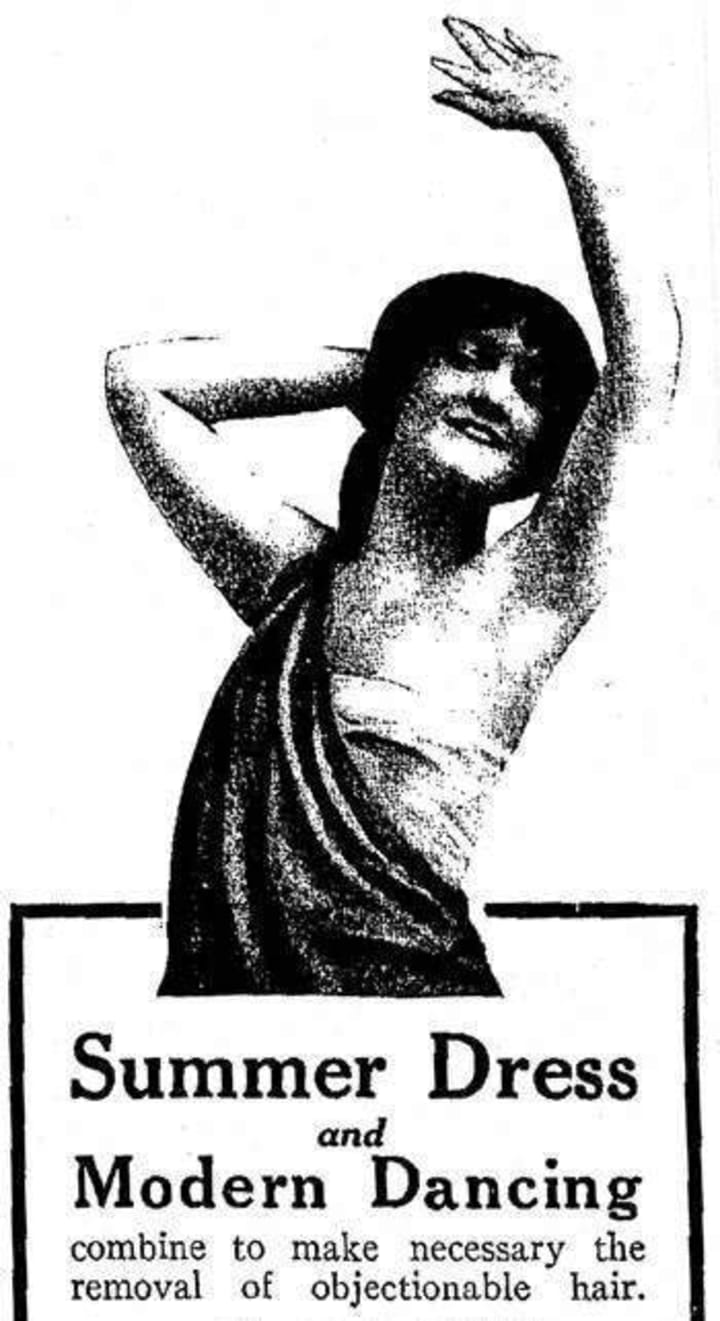Elective Torture: Why Do We Shave Our Body Hair?
I need someone to blame

Both sexes have a love-hate relationship with body hair removal. We’ve been pulling, plucking, burning, tweezing, and ripping out undesirable hair since the dawn of time. It’s believed that as far back as 4,000 B.C., women were using dangerous substances like arsenic and quicklime to get the job done.
The Egyptians, who never did anything halfway, removed all of their body hair from head to toe. They really liked the sleek look, but it also had a practical purpose. Being hairless discouraged the spread of disease and vermin such as lice and other icky creepy-crawlies.
Let’s fast-forward to more recent times. When did our modern-day obsession with silky-smooth armpits and legs first take hold? As far as armpits are concerned, we can pinpoint it almost to the day. In May of 1915, the upscale magazine Harper’s Bazaar ran an ad featuring a young model in a sleeveless, slip-like dress posing with both arms over her head.

You may be thinking, “So what?” Well, up until that time, fashion — and propriety — dictated that women were covered to the wrist and to the ankle. A dress that exposed the underarms was nothing short of revolutionary. In fact, just weeks earlier the mere mention of the word “underarm” had been enough to call for the smelling salts. Now, it was becoming perfectly acceptable.
It also meant since underarms were body parts that had always been covered, whether or not they needed shaving had been a moot point. If it didn’t show, why bother? And yet, here was an ad cajoling women to remove “objectionable” hair.
To think just days earlier women had no idea such a problem even existed!
There were several marketing strategies utilized to lure women onto the shaving bandwagon, most of which appealed to the timeless desire to be trendy. The obsession worked its way down to the middle class slowly but surely, as sleeveless and sheer dresses became popular with the masses.

Women’s razors and depilatories were finally offered for sale in the 1922 Sears Roebuck catalog. The very same year they started to sell — you guessed it — sleeveless and sheer dresses.
By this point, advertisers didn’t feel the need to justify their product’s purpose and could spend their budgets differentiating their brand from the competitors’. Women had been won over — or brainwashed — and it was no longer a question of convincing them if they should shave their underarms. Now it came down to convincing them that your particular product was the best choice to remove the hair that they didn’t realize until recently was objectionable in the first place.
The leg shaving phenomenon was a lot slower to catch on. Flappers in the 1920s ushered in the trend of much shorter dresses, but by the 1930s hemlines became much longer again. There were some fashion and beauty writers boldly referring to leg hair as a “curse,” but it seemed that the majority of women were content to leave well enough alone and not worry about shaving their legs. The fashion mavens just couldn’t stir up the same frenzy this time around.

It seemed that most women were a tad more hesitant when it came to shaving, and therefore drawing attention to, their legs as opposed to their underarms. After all, the leg’s closest neighbors are the *whispers*… private parts. You wouldn’t want anyone to think you were “that” kind of girl by giving men the wrong kind of impression.
Oh, Heaven forbid.
Then along came World War II, and that iconic pin-up picture of Betty Grable became a pop culture fixture almost overnight. It’s only a slight exaggeration to say that the women of America have been shaving their legs ever since.

Why, you ask? Because Betty’s legs looked amazing, and to emulate that look, you had to wear a short shirt and sheer stockings. You also had to shave your legs, as nothing killed the effect you were trying to create more than leg hair poking through your silky stockings.
Now, what about the guys?
It’s impossible to know who the first men to shave their beards were, but it’s pretty certain the story begins during the Stone Age. Cave paintings show Neanderthal man using seashells as tweezers to pluck out unwanted hairs.
Flint blades believed to be the first razors used for shaving have been dated back as far as 30,000 B.C. Flint would provide a very sharp edge, but would also become dull very quickly. Therefore, it’s probably safe to say that flint was man’s first disposal razor.
There is evidence that ancient Egyptian men shaved their beards for religious as well as aesthetic purposes. Generally, it’s the Egyptians who are credited with introducing shaving as part of a daily hygienic routine. Shaving was very important to Egyptian men, as facial hair was indicative of personal neglect. Affluent people kept a barber as a member of their household staff.

Alexander the Great introduced the practice of shaving to the Greeks around 300 B.C. He knew that a beard gives the enemy something to grab onto during battle, putting you at a distinct disadvantage. Not surprisingly, cropped hair and closely shaven skin was all the rage in Greece at the time, thanks to the influence of Alexander. He was so obsessed with looking spiffy that he wouldn’t forgo his grooming even in the midst of battle.
No-one can blame Alex. Who wants to be caught on the killing field with unsightly stubble?
A deep divide developed between the shaven and the unshaven — at least as far as the shaven were concerned anyway. As the practice of shaving spread, men from unshaven cultures were called “barbarians,” meaning the “unbarbered.”
The desirability of facial hair has gone in and out of vogue for centuries. Paintings and photos through the ages tell the story. Beard, no beard, lather, rinse, repeat.
So, our relationship with the removal of unwanted body hair is a long, colorful, and sometimes painful one. It’s pretty safe to assume shaving will continue to go in and out of fashion.

About the Creator
Kathy Copeland Padden
Political junkie, history buff, and music freak spending the End Times alternating betweencrankiness and bemusement. Come along! It's fun!






Comments
There are no comments for this story
Be the first to respond and start the conversation.